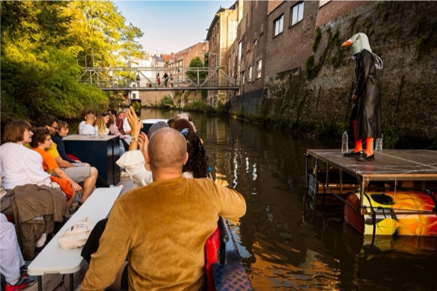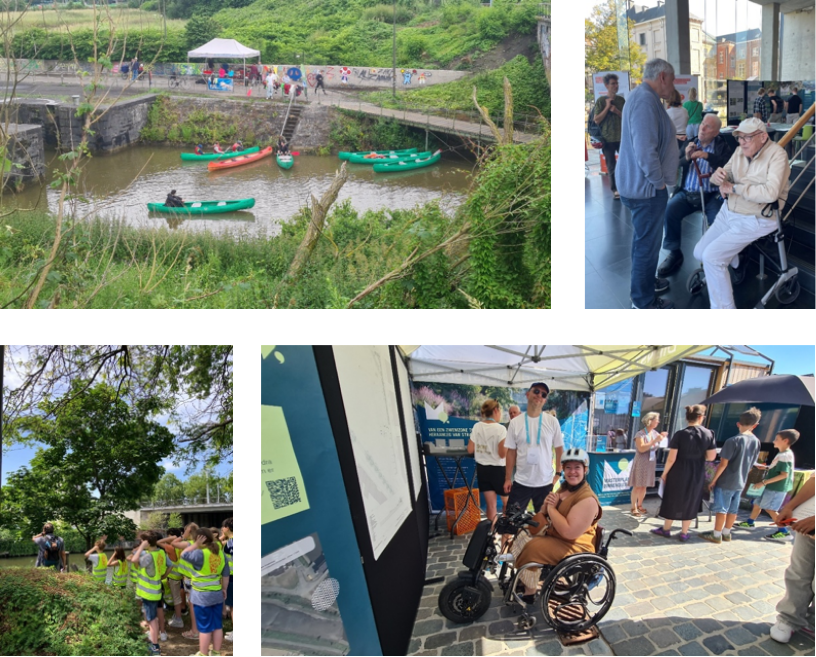In Mechelen (Belgium), a holistic project to restore and transform the river that runs through the city was subject to a large experiment in layered participation and inclusive design. The project focuses on making space for both nature and the public by restoring the river into a rewilded and cooling blue-green axis that offers abundant options for recreation, social cohesion, and enjoying the beauty of nature within the city. This was the ideal playground for experimenting with new techniques for involving people, including non-humans, in sustainable relationships with nature. This article describes how Mechelen achieved this inclusive project design through its various participatory “layers”.
Layered participation
In order to gather as many relevant voices as possible, ensuring that a diverse population’s creativity, needs and wishes are reflected in the reshaping of the river, the City of Mechelen designed a layered combination of different participation tracks:
1. The College of Mayor and Aldermen, the city council, and the advisory boards (youth, elderly people, disabled people, culture, sports, climate, etc.) were first asked to provide general advice on the project, its ambitions, and its trajectory.
2. A citizen assembly of 35 diverse residents was then formed. Over the course of four days, participants explored topics including biodiversity, public space, and accessibility. Five experts joined the discussions, and a guided boat trip made the river and its surroundings more tangible. The panel produced recommendations for transforming the river area into a more accessible and sustainable space. In this unique approach, members also represented non-human inhabitants (e.g. bats, reeds, fish) through personas, merging human and ecological interests into 15 guiding principles (read more here).


3. These principles were reviewed by specialists from different departments and project partners to overcome the ‘silo point of view’. They identified challenges and refined the principles to make them more feasible.
4. To reach out beyond ‘the usual suspects’, information stands were installed in strategic places. On the stands, a Citizen Dialogue Kit was mounted to measure experiences, wishes, needs, and beliefs. Over 2700 people responded to these questionnaires.
5. The city also set up expositions during neighbourhood events such as barbecues and festivals. Civil servants and researchers used these occasions to inform citizens and collect input through interviews, voting on AI-generated images, and evaluating activities.
6. Building on the Citizen Dialogue Kits and explorative research, the city identified less-engaged groups and created tailored activities to involve them:
- A boat trip and discussion with people in poverty
- An evening trip and creative workshop for children from underrepresented neighbourhoods
- Co-creation of a future swimming area with 16-year-old girls, discussing safety and gentrification
- On-site design sessions with disabled people for inclusive spaces
- Open classroom workshops with primary and secondary schools
- A design competition for furniture students and a tourism hackathon

7. A final exhibition and immersive experience showcased how residents’ input shaped the river’s shared future, with VR and 3D models bringing the plans to life.
An inspiring success story
Thanks to these participatory layers, plans have been drafted to make the city greener and more accessible. The city will begin by improving the river’s water quality through clean-up and better sewage management. Biodiversity will be restored in and along the river, through for example added greenery, birdhouses, and bee hotels. New leisure areas will make the banks more accessible, public spaces will be fun and safe for kids to play in, while artwork celebrating local fauna will highlight the area’s biodiversity. A swimming zone and kayaking areas will also be created.
River plans:

Swimming area plan:

Through creative activities, immersive experiences, and tools like VR and 3D modelling, the City of Mechelen made participation engaging and tangible. Even nature had a voice, reminding everyone the river belongs to more than just people. By combining imagination and care for all life, Mechelen showed that participation can be meaningful, fun, and inclusive.
Feeling inspired? Discover the future of the river project and details of its participatory tracks in the videos below, and perhaps become the next catalyst for your city’s nature-inclusive event.
